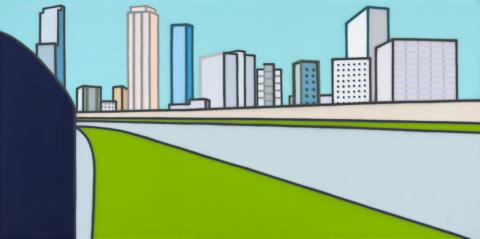A FREEWAY PAINTING (EXIT), 1994
HOWARD ARKLEY
synthetic polymer paint on canvas
182.5 x 365.5 cm
signed, dated and inscribed with title verso: Name Howard Arkley / Title A Freeway Painting (exit) / … / Date 1995 / …
Tolarno Galleries, Melbourne
Gould Galleries, Melbourne
Private collection, Victoria, acquired from the above in 1996
Gould Galleries, Melbourne
Corporate collection, Melbourne, acquired from the above in 2002
Howard Arkley: The Pointillist Suburb Series, Tolarno Galleries, Melbourne, 7 November 1994 – 3 December 1994, cat. 10
Downtown: Ruscha, Rooney, Arkley, Museum of Modern Art at Heide, Melbourne, 14 March – 14 May 1995
Into and Out of Abstraction, National Gallery of Victoria, Melbourne, 5 December 1995 – 5 February 1996
Cars and Culture: Our Driving Passions, Powerhouse Museum, Sydney, 10 December 1998 – 22 January 2000 (illus. in exhibition catalogue)
Howard Arkley: Gould Contemporary, Gould Galleries, Melbourne, 12 August – 2 September 2001, cat. 13 (illus. in exhibition brochure)
Howard Arkley: Gould Contemporary, Sydney, 16 March – 14 April 2002, cat. 9 (illus. in exhibition catalogue)
Engberg, J., Downtown: Ruscha, Rooney, Arkley, Museum of Modern Art at Heide, Melbourne, 1995, p. 19 (illus.)
Crawford, A. and Edgar, R., Spray: The Work of Howard Arkley, Craftsman House in association with G+B Arts International, Sydney, 1997, p. 116 (illus.)
Safe, M., ‘Four on the Floor’, The Australian Magazine, 5 – 6 December 1998, p. 27 (illus.)
Preston, E., Not Just a Suburban Boy, Duffy and Snellgrove, Sydney, 2002, p. 201
A Freeway Painting (Over Pass), 1994, acrylic on canvas, 203.5 x 305.0 cm, private collection, illus. in Crawford, A. and Edgar, R., Spray: The Work of Howard Arkley, Craftsman House in association with G+B Arts International, Sydney, 1997, p. 117
Howard Arkley was an excitable chap at the best of times, but when curator Juliana Engberg approached him with the notion of including him in an exhibition alongside his friend and critical ally Robert Rooney and his hero, American artist Ed Ruscha, in order to explore the suburban in art, Arkley was simply beside himself. Downtown: Ruscha, Rooney, Arkley at the Museum of Modern Art at Heide was indeed a potent and brilliantly curated show and, for all its obvious linkages, saw the three artists clashing vibrantly as they each staked a place in reinterpreting the world immediately around them. As critic Charles Green noted in Artforum magazine, Arkley, Rooney, and Ruscha had been ‘working through the paradoxical forms of the (sub)urban abyss for well over twenty years. These artists not only took the demon out of suburbia but, less obviously, made the familiar into something more than Pop defamiliarization achieved through repetition’.1
But it was arguably Arkley who stole the show with his fully resolved, classically balanced and vibrantly executed work, A Freeway Painting (Exit), 1994. The freeway as subject appeared comparatively late in Arkley’s practice and followed on from his clear victories via the suburban home and his factory works, and there is a certain frisson attached to his freeway paintings that was lacking in other works. There was a clear-cut reason for this. Unlike taking polaroids of his potential subject matter in quiet, shady suburban backstreets, Arkley would risk life and limb to capture the desired angle of the automotive bridges he wished to portray, dodging screaming traffic and blaring trucks in the process. Artist Callum Morton, who travelled with Arkley to Los Angeles – the capital of freeway architecture – believed Arkley’s tendency to leap into the fray of speeding traffic was borderline suicidal and, having witnessed it myself, I would agree that it was bordering on kamikaze art practice.
But the results! As A Freeway Painting (Exit) attests, the strange angle, the sense of daunting weight, the non-human environ, all combined to create a masterpiece of contemporary suburban portrayal. But, as always with Arkley, there is something wonderfully ‘off’ about this work. Part of this was the fact that he never portrayed vehicles in his freeway works, his roads are denuded of cars, lonely, silent expanses. A part of it may be the sense of yearning that A Freeway Painting (Exit) evokes. This is obviously an exit to the suburbs, the city still clearly a long drive away.
But the fact that we are heading somewhere is beyond dispute. The long expanse of grey siding draws us in, dragging us toward a left-hand exodus and avoiding the soulless generic city ahead. The fact that Arkley chose a verdant green for his tarmac, while utterly surreal, crystalises this odd sense of optimism.
That this work hit a nerve is beyond a doubt. First shown at Tolarno Galleries in 1994, post-Downtown it went on to be included in Into and Out of Abstraction at the National Gallery of Victoria in 1995 and then Cars and Culture: Our Driving Passions at the Powerhouse Museum, Sydney in 2000. What is astonishing, given the clear confidence evinced by the seeping line-work is the fact that A Freeway Painting (Exit) was in fact Arkley’s first engagement with this subject, the ground zero work in what would become a major part of his oeuvre.
While Arkley executed a number of paintings based on the freeway, most of them lack the level of intimacy of A Freeway Painting (Exit). And despite the fact that this is a massively-scaled, museum-quality work, it is tempting to pull up the couch and join Arkley as we turn left and avoid the rat-race of the impending metropolis and drive into the shady back streets of his suburbia.
1. Green, C., ‘Downtown: Arkley, Rooney, Ruscha’, Artforum, New York, November 1995
DR ASHLEY CRAWFORD
